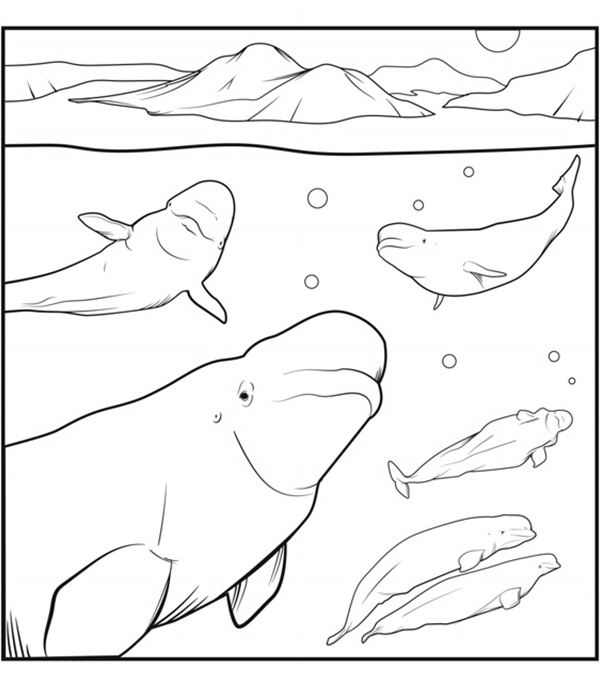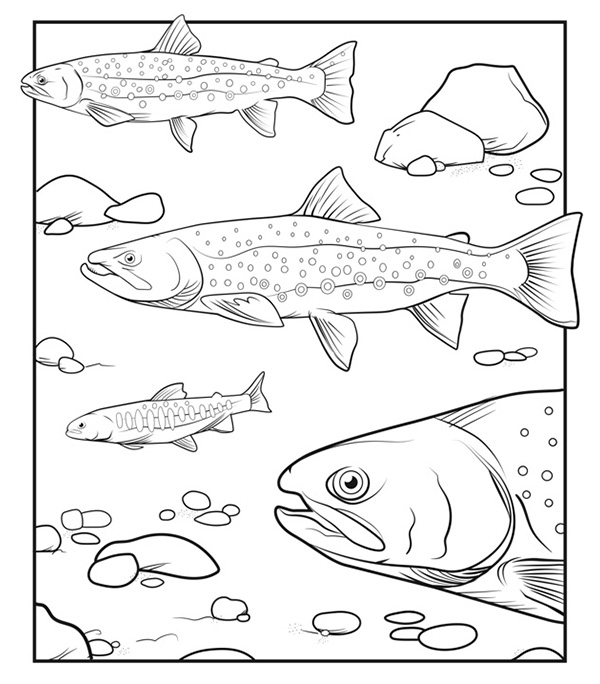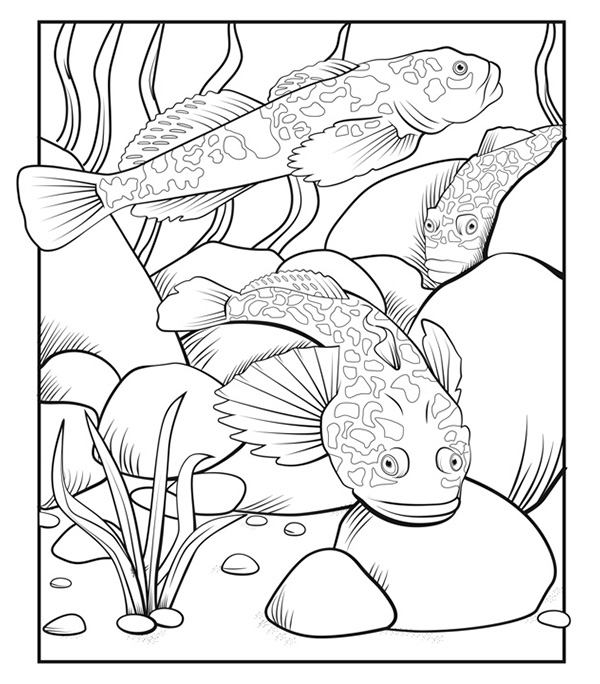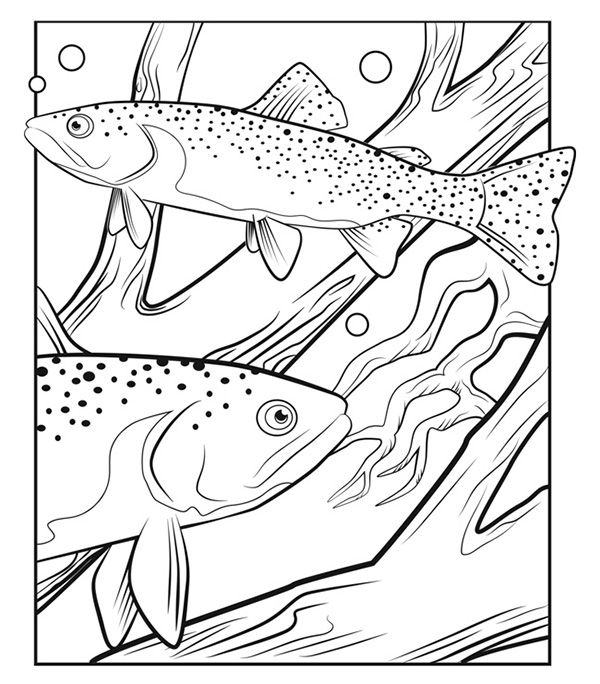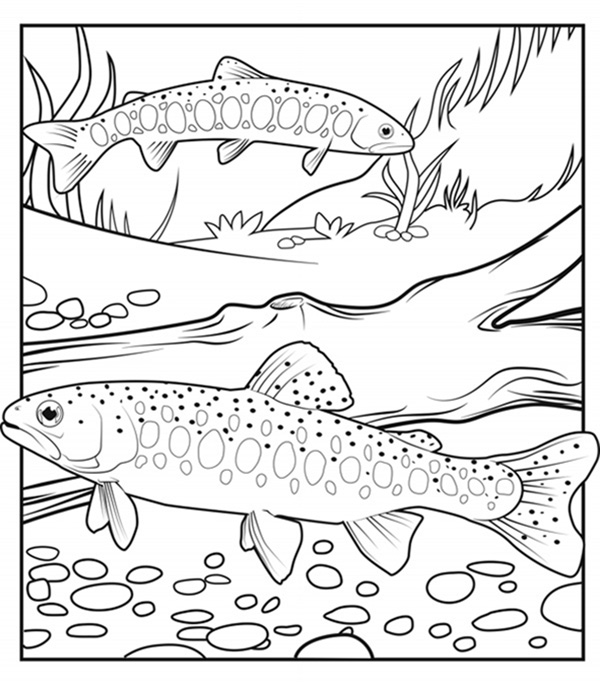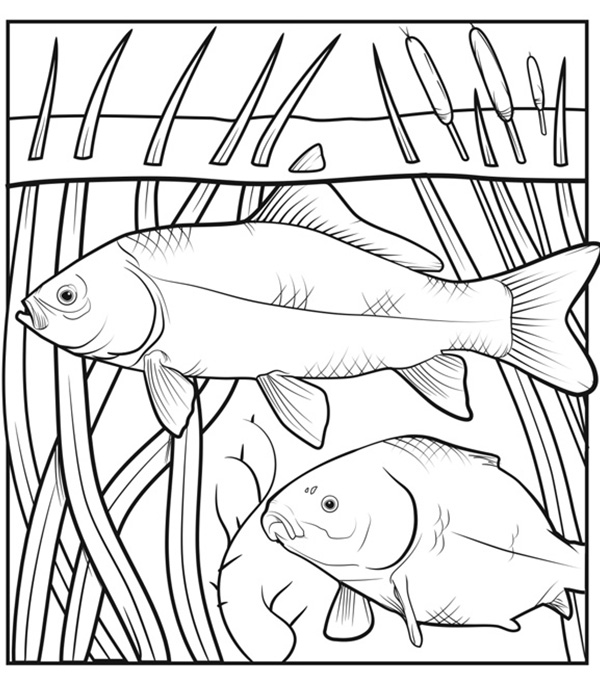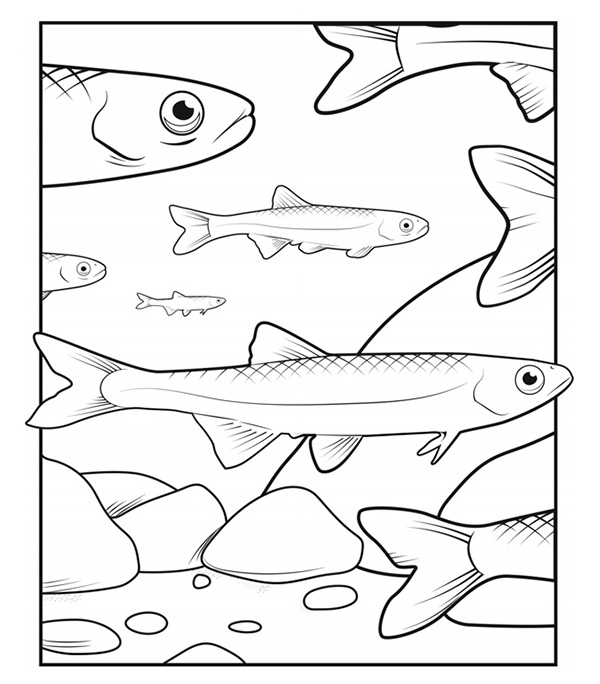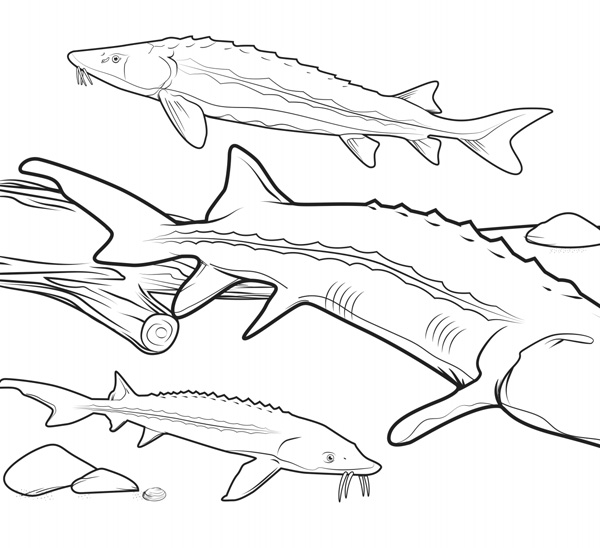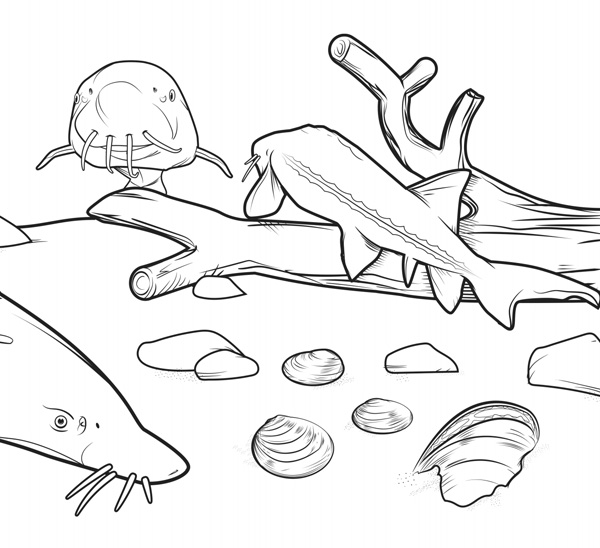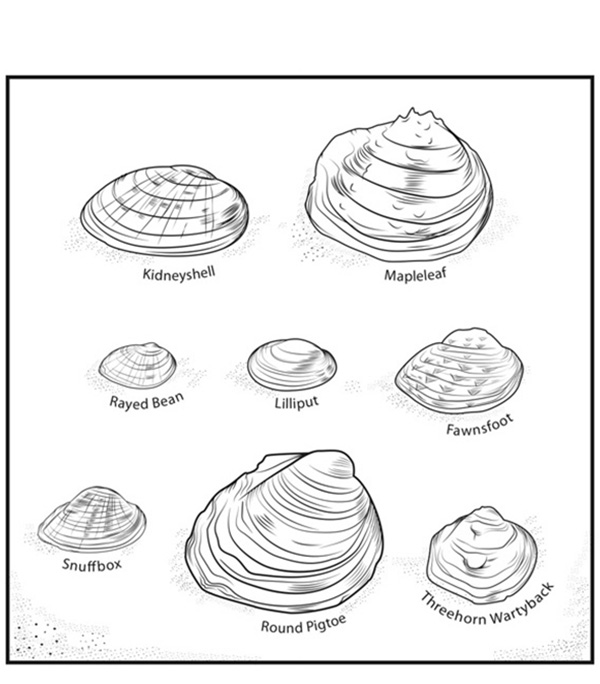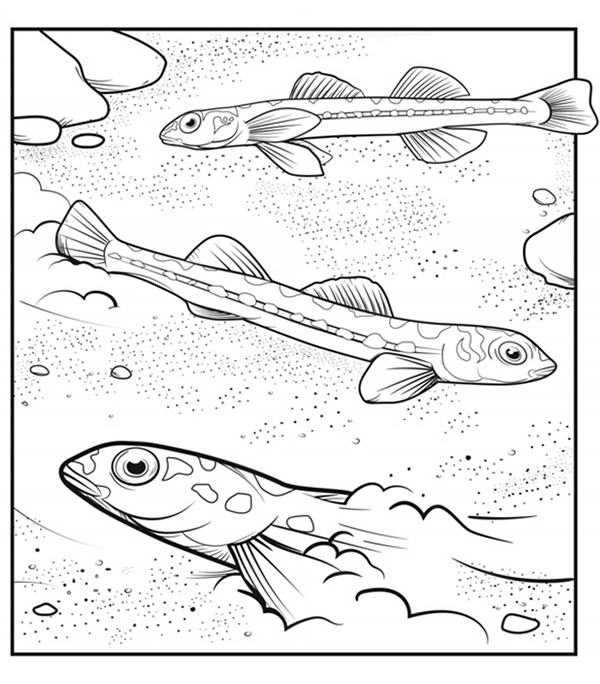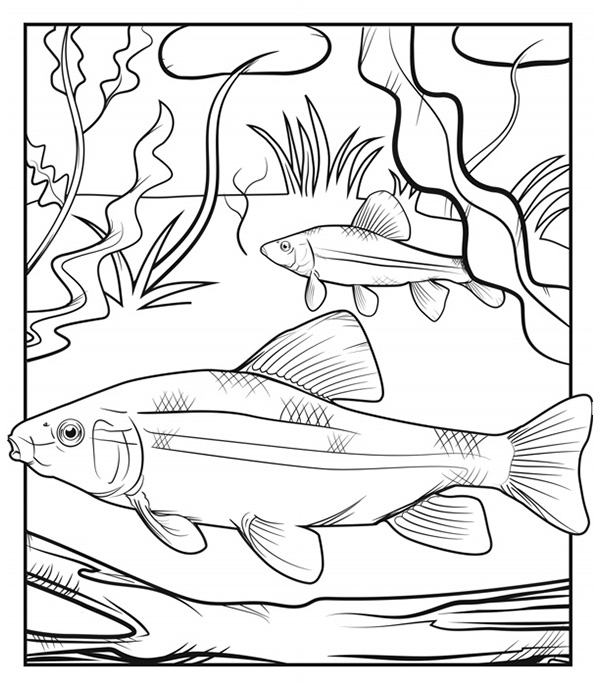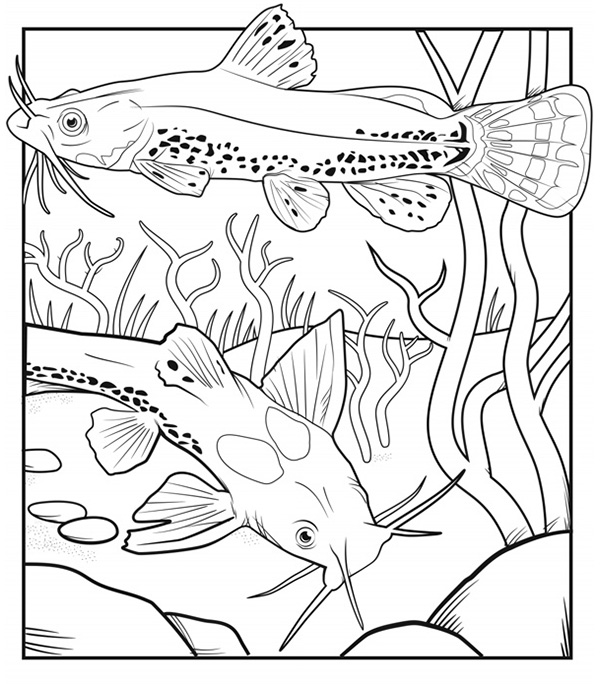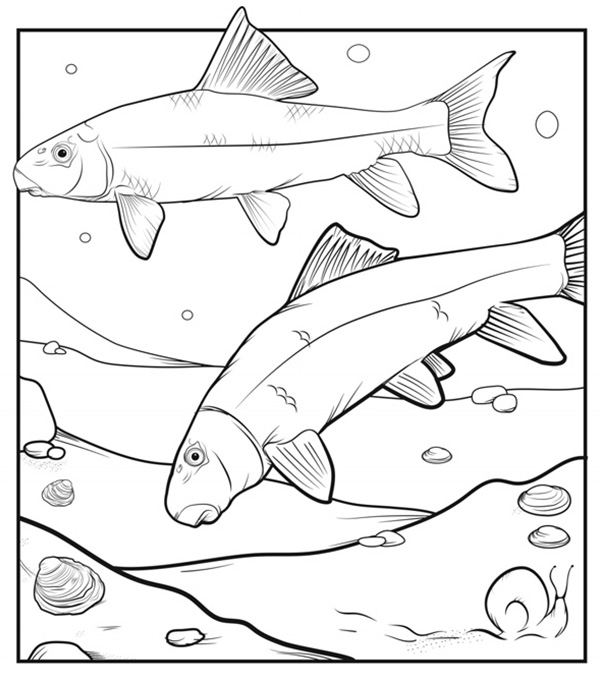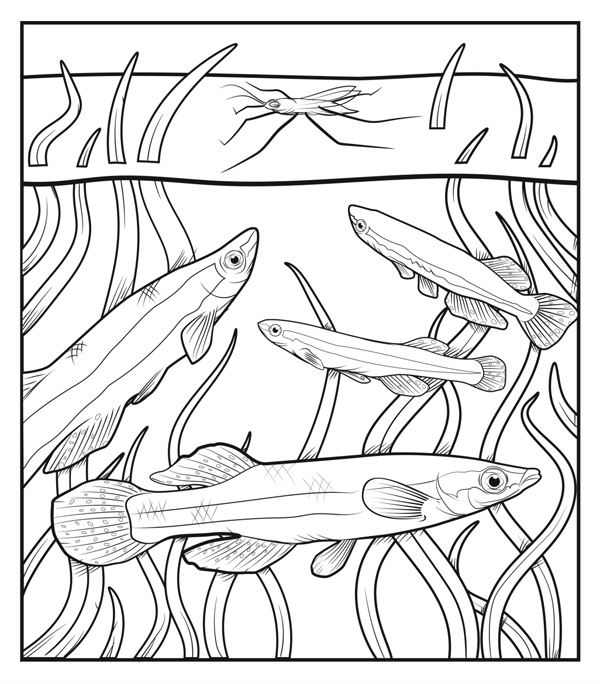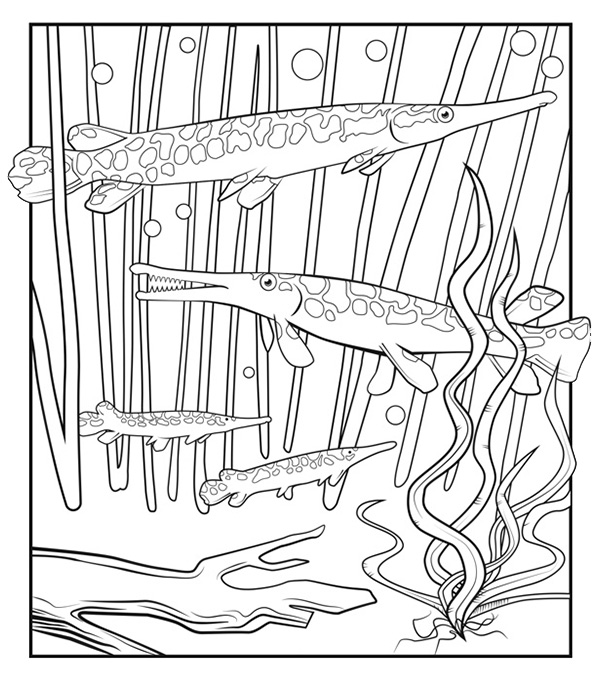Let’s Go for a Swim! Aquatic Species at Risk in Ontario, Prairies and Arctic
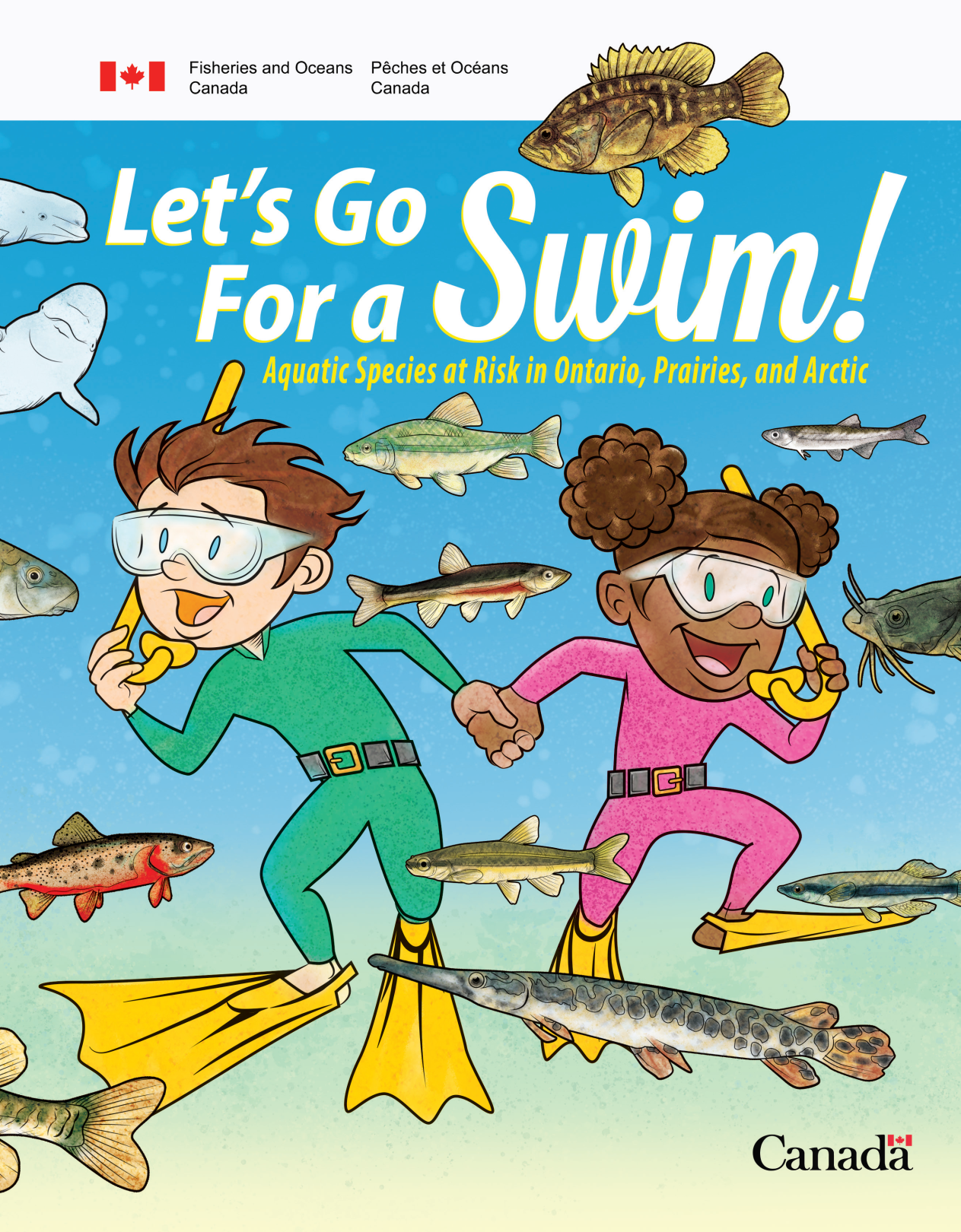
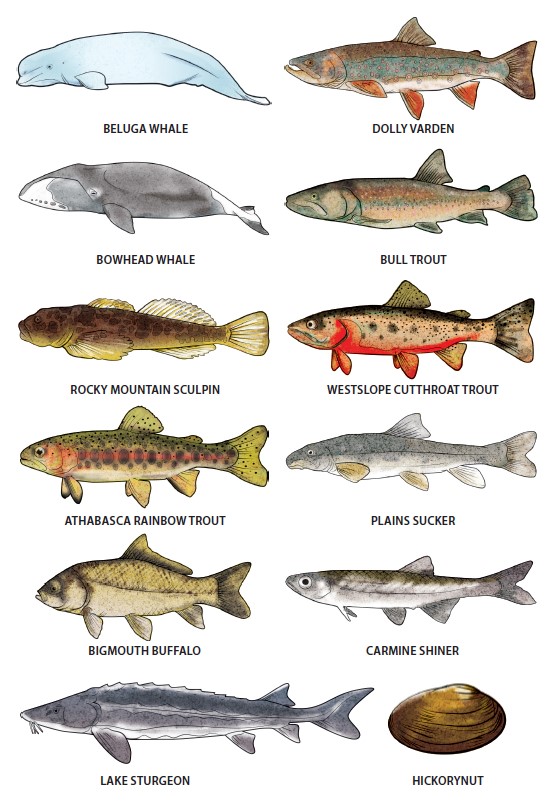
Illustrations of twelve aquatic species at risk featured in the colouring book including Beluga Whale, Dolly Varden, Bowhead Whale, Bull Trout, Rocky Mountain Sculpin, Westslope Cutthroat Trout, Athabasca Rainbow Trout, Mountain Sucker, Bigmouth Buffalo, Carmine Shiner, Lake Sturgeon, Hickorynut.
Aquatic Species at Risk Ontario, Prairies, and Arctic
The Ontario and Prairie Region of Fisheries and Oceans Canada (DFO) includes Alberta, Saskatchewan, Manitoba, and Ontario, while the Arctic Region includes the Yukon North Slope, Northwest Territories, Nunavut, Nunavik, Nunatsiavut, and Hudson and James Bay. This boundary is inclusive of Inuit Nunangat. The purpose of Canada's Species at Risk Act (SARA) is to conserve, protect and recover Endangered or Threatened species, and to encourage the management of species of Special Concern to prevent them from becoming further at risk. The Act aims to prevent indigenous species from becoming extirpated or extinct and preserve biodiversity within Canada.
Not all aquatic species at risk in Canada are shown in this book. For more information, including critical habitat and distribution data for all aquatic species listed under SARA, check out DFO’s National Aquatic Species at Risk Map.
You can zoom in to your area on the map to find aquatic species at risk near you!
A QR code is also included for readers to scan for access to the national species at risk map hyperlink above.
Table of Contents
- Beluga Whale
- Dolly Varden
- Bowhead Whale
- Bull Trout
- Rocky Mountain Sculpin
- Westslope Cutthroat Trout
- Athabasca Rainbow Trout
- Plains Sucker
- Bigmouth Buffalo
- Carmine Shiner
- Lake Sturgeon
- Hickorynut
- Freshwater Mussels
- Eastern Sand Darter
- Redside Dace
- Lake Chubsucker
- Warmouth
- Northern Madtom
- Grass Pickerel
- River Redhorse
- Blackstripe Topminnow
- Pugnose Shiner
- Spotted Gar
Beluga Whale (Arctic)
The Beluga Whale is very chatty, making a variety of clicks, whistles, squeals, and squawks using its blowhole. In early European whaling stories, Beluga’s are referred to as the “sea canary”.
The Beluga Whale is one of the most important marine animals of the Arctic: the skin “mucktuk” is eaten and it can be used in boots and laces.
Dolly Varden (Arctic)
Not all Dolly Varden in the Arctic are the same! Some come from the sea into rivers to spawn, some stay in rivers their whole lives, and some stay in the exact same stream their whole lives.
Bowhead Whale (Arctic)
The Bowhead Whale remains an important part of the traditional diet of Inuit peoples.
It is able to use its head and back to break ice over 20 cm thick to create holes that it can breathe through!
Bull Trout (Arctic, Alberta)
Like a salmon on the coast, the Bull Trout migrates very long distances to complete its life cycle. They are born in lakes and rivers in the mountains and can migrate distances up to 500 km; that’s like swimming from Red Deer, AB to Banff and back.
Rocky Mountain Sculpin (Alberta)
The Rocky Mountain Sculpin is a nocturnal fish and hides during the day under rocks or plants. It hunts at night on molluscs, small fish and insect larvae.
Westslope Cutthroat Trout (Alberta)
The Westslope Cutthroat Trout has a distinct red, pink or orange line along the underside of its lower jaw, which is why it’s named "cutthroat".
Athabasca Rainbow Trout (Alberta)
The Athabasca Rainbow Trout has eight to twelve large bluish-grey oval marks along its sides, known as parr marks.
Female Athabasca Rainbow Trout build nests called “redds” in the gravel with their fins to hold and protect their eggs.
Mountain Sucker (Alberta, Saskatchewan)
The Mountain Sucker, that soon will be called the Plains Sucker, lives in a wide range of habitats and can survive natural disturbances such as fire, droughts and floods. Female Plains Sucker tend to be larger and live longer than males.
Bigmouth Buffalo (Saskatchewan, Manitoba)
The Bigmouth Buffalo can live over 100 years, making it one of the longest-lived freshwater fish in Canada!
The Bigmouth Buffalo is a member of the sucker family, but unlike other suckers, it feeds on plankton and small insects in the water column instead of bottom dwelling critters.
Carmine Shiner (Manitoba)
The Carmine Shiner is named after its cheeks and fins that turn a bright orange-red colour when spawning (carmine means red).
Lake Sturgeon (Alberta, Saskatchewan, Manitoba, Ontario)
The Lake Sturgeon has survived for over 200 million years and is sometimes called a ‘living dinosaur’. The oldest known Lake Sturgeon in Canada was 155 years old!
The Lake Sturgeon has rows of bony plates called ‘scutes’ on its body like armor. These scutes are pointy when Lake Sturgeon are young, but they become smoother in old age.
Hickorynut (Ontario)
Did you know that young mussels depend on a host fish to complete part of their life cycle? In some areas, young Hickorynut (a freshwater mussel) attach to the gills of a Lake Sturgeon to feed without damaging the fish. As they get bigger they fall off and settle onto the bottom of a river or lake where they mature.
Lake Sturgeon and Hickorynut are also in Quebec. The first recorded Hickorynut was discovered in the Ottawa River in 1885, about 15 km away from Canada’s Parliament.
Freshwater Mussels (Manitoba, Ontario)
There are 55 different freshwater mussels in Canada, and 41 of them can be found in Ontario! Mussels spend most of their life out of sight, almost completely buried at the bottom of rivers and lakes. You can count the rings on a mussel shell to guess how old it is.
Freshwater mussels are filter feeders, which means they pump water into their shells and feed on tiny pieces of algae, bacteria and other things in the water. You can think of them as nature’s water filters – each adult mussel cleans about 40 litres of water per day!
Eastern Sand Darter (Ontario)
The Eastern Sand Darter is slender and you can see through its skin! This provides the perfect camouflage for blending in with sandy river bottoms.
Image description: Black and white illustration of three Eastern Sand Darters. Two can be seen swimming over a sandy river bottom and a third that appears partially nestled beneath the sandy bottom, with only the head visible. The illustration is enclosed within a black rectangular border on the page.
The Eastern Sand Darter often completely buries itself in sand beds to avoid fast flowing water.
Redside Dace (Ontario)
The Redside Dace is a surface feeder and often leaps several centimetres out of the water to capture flying insects with its very large mouth.
Adults are extremely colourful with a bright red and brilliant yellow stripe along its side.
Lake Chubsucker (Ontario)
The Lake Chubsucker feeds mainly on plankton, small crustaceans and molluscs, aquatic insects, algae and other plant matter.
The Lake Chubsucker is very rare in Canada!
Warmouth (Ontario)
The Warmouth feeds on crustaceans and aquatic insects when small, and on fishes, crayfishes and molluscs when larger.
Warmouth may lay eggs several times a year and the male will protect the eggs from predators after they are laid.
Northern Madtom (Ontario)
Did you know the Northern Madtom has poison within its spines that is similar to a bee sting?
The Northern Madtom has two large, light coloured spots in front of its dorsal fin.
Grass Pickerel (Ontario)
The Grass Pickerel is a torpedo-shaped fish with a large mouth and many teeth. It sneaks up on its prey and mainly feeds on other fishes, but will also eat aquatic insects and crayfishes.
The Grass Pickerel can tolerate a wide range of water temperatures and conditions, which may allow it to use shallow wetland habitats that would be unsuitable for other predatory fish.
River Redhorse (Ontario)
Did you know the River Redhorse has teeth in its throat called pharyngeal teeth? These teeth are adapted for crushing the shells of mussels, snails and crayfishes.
Because of its pharyngeal teeth (throat teeth), River Redhorse is believed to help control invasive mussels such as Zebra Mussel.
Blackstripe Topminnow (Ontario)
The Blackstripe Topminnow spends most of its time swimming at the surface looking for food.
Did you know that the Blackstripe Topminnow feeds mostly on insects that fall from trees or plants along shorelines?
Pugnose Shiner (Ontario)
Did you know the Pugnose Shiner’s scientific name means “without a chin” in Greek? With its small mouth it angles up sharply and will feed on plants and small aquatic animals.
This minnow is easily frightened and will quickly find places to hide, using underwater plants as cover.
Spotted Gar (Ontario)
The Spotted Gar has a long snout and mouth full of sharp teeth that it uses to catch small fish for food.
Spotted Gar can breathe underwater with its gills and it also breathes air above water using its swim bladder organ.
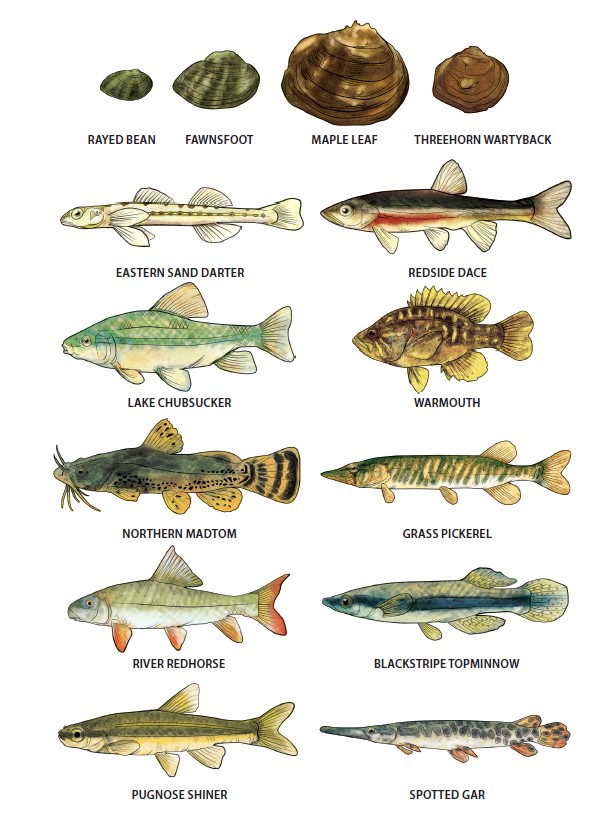
Colour illustrations of species at risk mussels and fishes featured in the colouring book, including four mussels (Rayed Bean, Fawnsfoot, Mapleleaf, and Threehorn Wartyback) and ten fishes at risk (Eastern Sand Darter, Redside Dace, Lake Chubsucker, Warmouth, Northern Madtom, Grass Pickerel, River Redhorse, Blackstripe Topminnow, Pugnose Shiner and Spotted Gar).
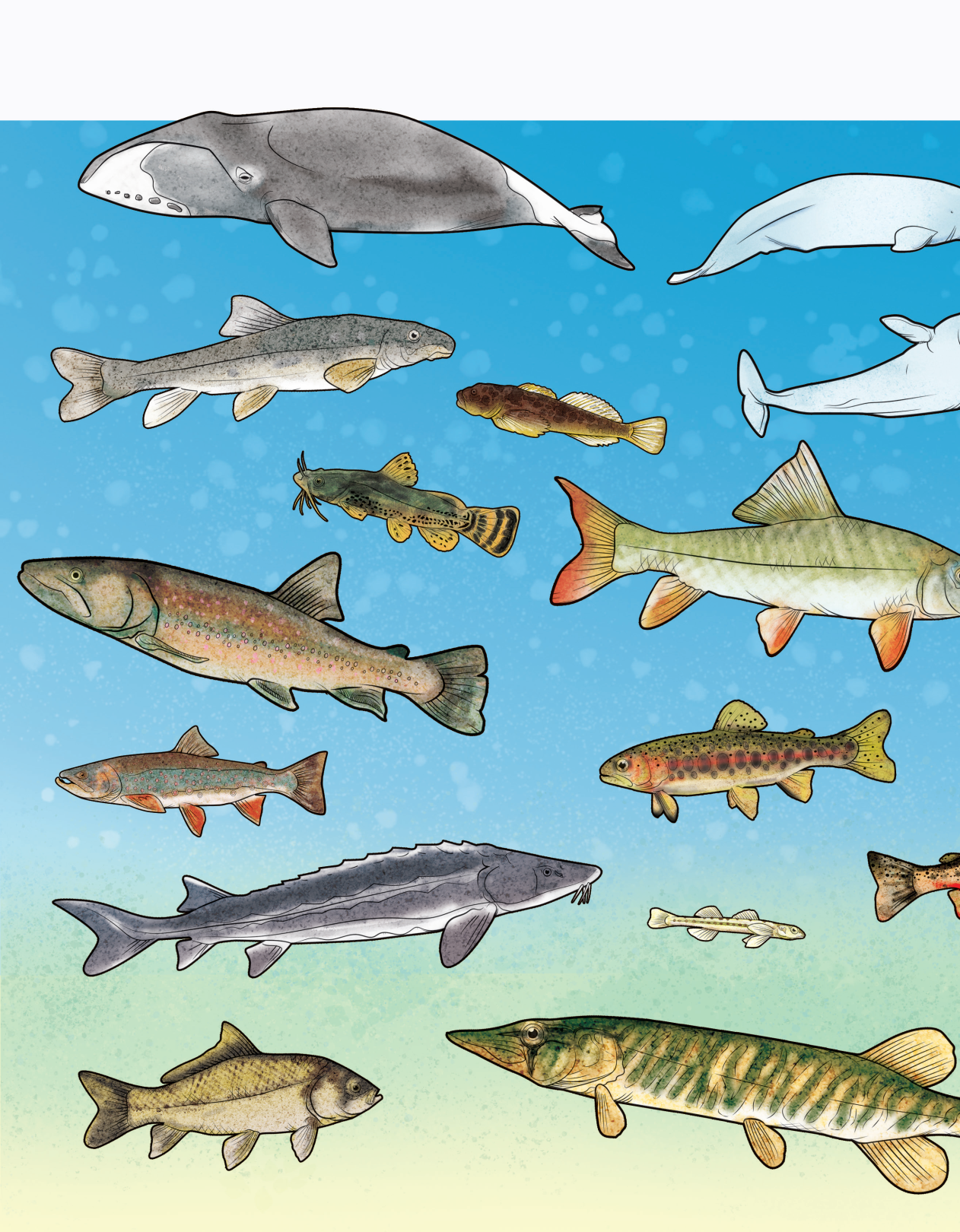
Colour illustrations of fifteen species at risk featured in the colouring book swimming among a blue and green water column background, including Bowhead Whale, Beluga Whale, Plains Sucker, Rocky Mountain Sculpin, Northern Madtom, River Redhorse, Bull Trout, Dolly Varden, Athabasca Rainbow Trout, Lake Sturgeon, Eastern Sand Darter, Bigmouth Buffalo, and Grass Pickerel.
- Date modified:
